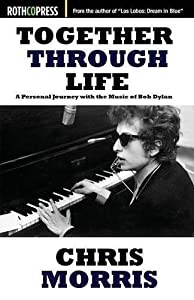An Author’s Personal Journey with the Music of Bob Dylan

This is the first installation in our new series, Favorite Bob Dylan Books. As there are so many books all about this one songwriter, we are offering our help in identifying the truly great ones most deserving of attention.
Videos by American Songwriter
Chris Morris’ approach to writing a Dylan book is founded on informed passion. As a longtime, respected music writer with Variety who has also contributed to Billboard, Musician, The Hollywood Reporter and Los Angeles Reader, and as the author of the great Los Lobos: Dream In Blue, Chris Morris knows way more about music than most humans; throughout the book he shares enough facts to frame the story neatly into the context of Dylan’s career.
But he also does something different. He also brings the power of a music lover’s true passion (and sometimes antipathy) for this artist and his music. Which is more real in many ways, and more powerful, than an objective book about Dylan and his history (which has already been done countless times).
Rather than play the acceptable though phony game of adopting a cool, dispassionate voice, keeping his own feelings out of the thing, he does the opposite. And it works. He gives us a charged, poignant journey through all of Dylan’s albums, from the first onward. Each is wrapped around Morris’ feelings concerning each album and their station in his life, colored by the often dark, raw realities of his personal passage.
Admittedly, it’s not an approach which initially warmed me to the book. My kneejerk reaction was to conclude that while this might shed some light into Morris’ heart and mind, it would offer precious little about Dylan which I didn’t know.
I was wrong. Once again.
Also initially irksome was his complete dismissal of certain Dylan songs and albums which are among my personal favorites, especially Desire and Infidels.
But as I delved in, I got beyond my initial reaction, accepted he was wrong, of course, but was interested in finding out why.
More than that was admiration for the accomplishment. Here he’s essentially breaking the rules of music journalism, but with writing so passionate and vivid that it becomes a true triumph. It brings home the reality of musical awareness, which is that songs and records hit us in different ways for so many different reasons. Much of which, as Morris makes clear, has to do precisely with the circumstances of our personal lives which color our perceptions of music. Nobody, for example, ever heard a broken-hearted love song in the same way after being broken-hearted. Or even more powerfully, as related by Morris, in the very midst of romantic turmoil.

It’s the reason no album seems to have impacted him quite as profoundly as Blood On The Tracks, Dylan’s most naked song cycle ever about the joy and sorrow – mostly sorrow, actually – of love. Morris’ own romantic tribulations – and the fact that the object of his ardor was also a redhead, like the one mentioned in the album’s opening song – is what brought him so close to this album in every way.
But the effect of Morris’ entire journey through all the albums, and the ways in which they impacted his life, or did not, is revelatory. Because he’s such a gifted writer, with a poetic yet concise command of language fusing the details of his life with those of Dylan’s work, the thing resonates with the raw intensity of a Bukowski novel. That his feelings about the music are authentic is never in question. Even when he soundly lavishes scorn on an album, such as The Basement Tapes (called “this fraudulent product”), or delivers judgment on those with some merit but still ruinously flawed, such as our beloved Desire (described as “a rumpled, perplexing record”), his fervor in unpacking all perceived inadequacies is absorbing, and indicative of just how powerful this stuff is.
Because whether its joy or outrage expressed, it’s never indifference, a testament to how seriously he receives Dylan, and all the reasons Dylan earned this esteem. The fury expressed at certain albums is only of that intensity because he measures them against the Dylan albums he considers masterpieces, causing their unfocused failures to seem especially egregious.
And part of the fun of this journey is arguing with the author in your head about certain ideas, as we argue with our friends about their wrong opinions. (Which doesn’t mean doing it with the actual author, who has already made his case. Unless he invites it, of course.)
The result of this unorthodox approach is an enlightening exploration of how music is perceived, and how potently that perception is shaped by circumstance, preconception and personal preference. Sometimes it’s the sound of the record, or the arrangement of the song, that puts him off, as with “Changing Of The Guards,” which is marred by incessantly echoing background vocals. Sure, it would be a joy to remix that track, so as to repeal and replace that echo choir with silence. But does it still stir something ancient when he sings, “They shaved her head/she was torn between Jupiter and Apollo/a messenger arrived with a black nightingale”? Well, for me it does. Just as I did really enjoy the first bogus but official Basement Tapes, even with its inferior sound. Those were a raggedy bunch of songs, and that low-fi sound always seemed well suited to the proceedings.
But I get it. That’s me. And this is the beauty of the book, that it will spark countless arguments like this one about which albums matter most, and why, and which songs. And it’s Morris’ passion for this artist and his art, regardless of which stations of Dylan’s musical cross upon which he comments, that outshines all other concerns. Unlike so many doctrinaire Dylan fans who had no love for his two recent albums of standards, Shadows In the Night and Fallen Angels, Morris rises above the conventional clamor to find greatness in the latter, proving beyond any doubt that his understanding of all Dylan’s dimensional, oft-perplexing thinking, is keen. His celebration of the greatness of this album (mirroring that of the late songwriter P.F. Sloan, who told me it was the “album Dylan always wanted to make, as it crystallizes the greatness of songwriting itself”), shows an insight into the man and his often misread intentions so often missed by scribes over this long strange ride.
As with all of these chapters, the language is both precise and poetic, and beautifully evocative with the recognition of something people have been trying to fathom for decades now, why Dylan is Dylan. The love of song itself, the sensuality of words sung in meter and tune, as shaped by traditional song-craft, was always at the heart of the journey, regardless of genre, as Morris explains with grace:
“Why has Dylan taken to those often overripe, backdated things? … I believe it is because he likes the way the lyrics fall off his tongue. Dylan has always been an artist drunk with words, one who likes to crash them against each other just to hear the chime and clatter they make, and his on-point, precisely-measured, irony-free readings of the old lyrics finds him simply savoring the sound of them. There’s a smile in the way he sings…”
After reading and rereading Together Through Life a couple times now, what remains most is great affection from this writer towards this artist who sometimes inspired and delighted him, sometimes offended him, often perplexed him, and sometimes provided the exact song at the exact moment when life and romance conspired to bring him to the edge. That Dylan was always there for him when on that edge, as he is for so many of us, is undeniable. If you’re one of these, one whose life has been profoundly impacted repeatedly over the decades by the music of this one man, you will appreciate this book. You might not agree with all of it! But it might very well make you return to the albums you dismissed, as well as those you championed, sparked by passion so well expressed it seems easy.
